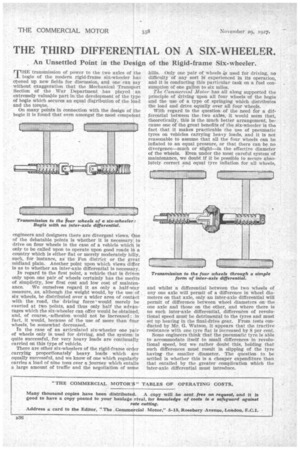THE THIRD DIFFERENTIAL ON A SIX-WHEELER.
Page 62

If you've noticed an error in this article please click here to report it so we can fix it.
, An Unsettled Point in the Design of the Rigid-frame Six-wheeler.
TFIE transmission of power to the two axles of the bogie of the modern rigid-frame six-wheeler has opened up new fields for discussion, and one can say without exaggeration that the Mechanical Transport Section of the War Department has played an extremely valuable part in the development of the type of bogie which secures an equal distribution of the load and the torque.
On many points in connection with the design of the bogie it is found that even amongst the most competent engineers and designers there are divergent views. One of the debatable points is whether it is necessary to drive on four wheels in the case of a vehicle which is only to be called upon to operate upon good roads in a country which is either flat or merely moderately hilly, such, for instance, as the Fen district or the great midland plain. Another point upon which views differ is as to whether an inter-axle differential is necessary.
In regard to the first point, a vehicle that is driven only upon one pair of wheels certainly has the merits of simplicity, low first cost and low cost of maintenance. We ourselves regard it as only a half-way measure, as, although the weight would, by the use of six wheels, be distributed over a wider area of contact with the road, the driving force' would merely be exerted at two points, and thus only half the advantages which the six-wheeler can offer would be obtained, and, of course, • adhesion would not be increased in fact, it would, because of the use of more than four wheels, be somewhat decreased.
Tn the case of an articulated six-wheeler one pair of wheels only is used for driving, and the system is quite successful, for very heavy loads are continually carried on this type of vehicle.
There are other six-wheelers of the rigid-frame order carrying proportionately' heavy loads which are equally successful, and we know of one which regularly carries a load of nine tons over a journey which entails a large amount of traffic and the negotiation of some
hills. Only one pair of wheels .its used for driving, no difficulty of any sort 1§ experienced in its operation, and it is conducting this particular task on a fuel consumption of one gallon to six miles.
The Commercial Motor has all along supported the principle of driving upon all four wheels of the bogie and the use of a type of springing which distributes the load and drive equally over all four wheels. With regard to the question of the need for a differential between the two axles, it would seem that, theoretically, this is the much better arrangement, because one of the great benefits of the six-wheeler is tha fact that it makes practicable the use of pneumatic tyres on vehicles carrying heavy loads, and it is not reasonable to assume that all the four wheels can be inflated to an equal pressure, or that there can be no divergence—much or slight—in the effective diameter of the wheels. Even under the most careful system of maintenance, we doubt if it be possible to secure absolutely correct and equal tyre inflation for all wheels, and whilst a differential between the two wheels of any one axle will permit of a difference in wheel diameters on that axle, only an inter-axle differential will permit of difference between wheel diameters on the one axle and those on the other, and where there is no such inter-axle differential, differences of revolutional speed must be detrimental to the tyres and must set up heating in the final-drive gear. From tests conducted by Mr. G. Watson, it appears that the tractive resistance with one tyre flat is increased by 8 per cent.
Some engineers think that the pneumatic tyre is able to accommodate itself to small differences in revolutional speed, but we rather doubt this, holding that such differences must result in slipping of the tyre having the smaller diameter. The question to be settled is whether this is a cheaper expenditure than that entailed by the greater complication which the inter-axle differential must introduce.




















































































































